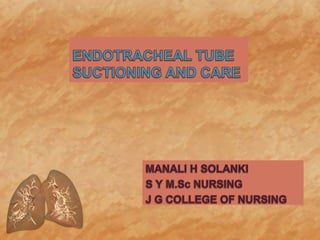
Et tube suctioning ppt
- 2. • Endotracheal suctioning is a component of bronchial hygiene therapy and mechanical ventilation and involves the mechanical aspiration of pulmonary secretions from a patient with an artificial airway in place.
- 4. • ETT suctioning is defined as the procedure to remove pulmonary secretion mechanically from the patient’s airway passages via nose or mouth where ETT (Endotracheal tube) is in place.
- 5. • To maintain a patent airway by removing accumulated tracheobronchial secretions using sterile technique. • To improve oxygenation and reduce the work of breathing. • Stimulate the cough reflex. • Prevent infection and atelactasis from the retained secretion.
- 6. The need to remove accumulated pulmonary secretions as evidenced by one of the following: • Coarse breath sounds by auscultation of lungs or 'noisy' breathing.(rhonchi sound) • Increased peak inspiratory pressures during volume-controlled mechanical ventilation or decreased tidal volume during pressure-controlled ventilation.
- 7. • Patient's inability to generate an effective spontaneous cough. • Visible secretions in the airway. • Changes in monitored flow and pressure graphics. • Deterioration of arterial blood gas values. • Suspected aspiration of gastric or upper airway secretions. • Clinically apparent increased work of breathing.
- 8. • An endotracheal tube is an artificial airway inserted into the trachea through the mouth or nose. It is usually made of polyvinyl chloride.
- 10. • It is available in various sizes . the size is indicated by internal diameter (ID) in millimeters.8/ 8.5 mm ID used for adult male & 7/7.5 mm ID used for adult female.
- 11. • Hypoxemia ( decreased O2 in the blood) • Dysrhythmias • Nosocomial pulmonary tract infection (most common complication of ETT tube suctioning)
- 12. Atelectasis
- 13. • Sepsis • Mucosal trauma with increase secretions • Cardiac arrest
- 16. • Observe for the sign and symptoms of need to perform ET tube care: soiled or loose tape, pressure sore or nares, lips or corner of mouth, and excess nasal or oral secretions. • Observe for factors that increase risk of complications from ET tube: type and size of tube, movement of tube up and down trachea( in and out), duration of tube placement, cuff over inflation or under inflation, presence of facial trauma, malnutrition and neck or thoracic radiation.
- 17. • Assess client’s knowledge of procedure. • Obtain another nurse’s assistance in the procedure. • Explain procedure and client’s participation including importance of the following: not biting or moving ET tube with tongue, trying not to cough when tape is off ET tube, keeping hands down and not pulling on tubing, removal of tape from face can be uncomfortable.
- 18. • Assist client to assume position comfortable for both nurse and client(usually supine or semi fowler’s) • Wash hands and administer endotracheal, nasopharyngeal and oropharyngeal suction.